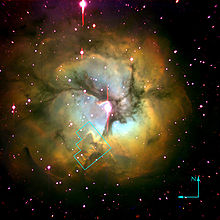Trifid Nebula
| Emission nebula | |
|---|---|
| H II region | |
| reflection nebula and dark nebula | |

|
|
| Observation data: J2000 epoch | |
| Right ascension | 18h 02m 23s |
| Declination | −23° 01′ 48″ |
| Distance | 5200 ly (1,600 pc) |
| Apparent magnitude (V) | +6.3 |
| Apparent dimensions (V) | 28 arcmins |
| Constellation | Sagittarius |
| Physical characteristics | |
| Radius | 21 ly |
| Designations | M20, NGC 6514,Sharpless 30, RCW 147, Gum 76 |
The Trifid Nebula (catalogued as Messier 20 or M20 and as NGC 6514) is an H II region located in Sagittarius. It was discovered by Charles Messier on June 5, 1764. Its name means 'divided into three lobes'. The object is an unusual combination of an open cluster of stars; an emission nebula (the lower, red portion), a reflection nebula (the upper, blue portion) and a dark nebula (the apparent 'gaps' within the emission nebula that cause the trifurcated appearance; these are also designated Barnard 85). Viewed through a small telescope, the Trifid Nebula is a bright and peculiar object, and is thus a perennial favorite of amateur astronomers.
The Trifid Nebula is a star-forming region in the Scutum spiral arm of the Milky Way. The most massive star that has formed in this region is HD 164492A, an O7.5III star with a mass more than 20 times the mass of the Sun. This star is surrounded by a cluster of approximately 3100 young stars.
The Trifid Nebula was the subject of an investigation by astronomers using the Hubble Space Telescope in 1997, using filters that isolate emission from hydrogen atoms, ionized sulfur atoms, and doubly ionized oxygen atom. The images were combined into a false-color composite picture to suggest how the nebula might look to the eye.
The close-up images show a dense cloud of dust and gas, which is a stellar nursery full of embryonic stars. This cloud is about 8 ly away from the nebula's central star. A stellar jet protrudes from the head of the cloud and is about 0.75 ly long. The jet's source is a young stellar object deep within the cloud. Jets are the exhaust gasses of star formation and radiation from the nebula's central star makes the jet glow.
...
Wikipedia
